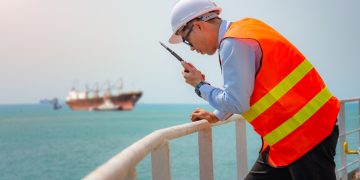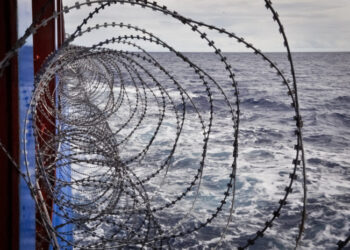Abandon ship drills are an important aspect to ensure safety onboard, even in times of crisis. While these drills are commonly taking place along with other drills, such as fire drills, knowing how to properly act when an abandon ship situation occurs can really save lives. For this reason, John Southam, Loss Prevention Executive, North P&I Club, shares vital information on how to ensure a safe and efficient abandon ship drill.
Often an abandon ship drill is treated as an afterthought to another drill. For example, the main focus will be on the fire drill that precedes it, and afterwards the crew simply muster donning a lifejacket and then finish. But knowing what to do and when to do it in the event of an abandon ship situation is a matter of life and death. So why should it not be a full and properly formatted drill of its own?
Just as importantly, accidents during lifeboat drills – mostly involving hook on-lead release systems when lowering or recovering the lifeboat – continue to occur.
As with the other drill articles in this series, we give you the ‘drill bits’ – the different elements of the drill. This is to make sure that the crew are familiar with and confident in their actions during a given drill.
Preparation
Complete a full risk assessment prior to the drill – DRILLS MUST BE SAFE!!
This should include assessing whether the weather, environmental conditions, and situation allow for safe lowering, operation and recovery of the lifeboat(s) by the crew. Use appropriate fall prevention devices and ensure crew are confident in their use. Check operational status and all maintenance is up to date for the relevant emergency equipment.
Split the crew into three small teams and conduct separate training sessions, each led by a responsible officer. Each team should rotate to the next leader once they have completed each training station, so all crew receive the same training to help in carrying out their emergency duties and responsibilities.
1. Bridge Team
- Location: Bridge
- Group leader: Master
Learning Objectives:
- Demonstrate use of GMDSS: remember this equipment isn’t just bridge radio equipment!
- Show the team where to locate the search and rescue transponders (SART) and how they work
- Using the test function, show the team the concentric circles on the 3cm radar (if there are no other vessels in the area)
- Show the team the Emergency Position Indicating Radio Beacon (EPIRB), explain how it floats free and how to manually remove it from its position.
- Demonstrate the location and use of the GMDSS handheld radios, point out to the team where the spare batteries are.
- Explain the content of the contingency plans relating to abandon ship and where they can be found. Check all relevant situations are addressed in the plans and that the contents are accurate.
- Understand record-keeping. Describe how training records should be maintained, remembering that these may prove to be valuable evidence in the event of an incident.
2. Liferaft Team
- Location: At one of the liferaft muster points
- Group Leader: 3rd Mate
Learning Objectives:
- Discuss the importance of mustering promptly. The type of vessel and the nature of the incident that leads to an abandon ship situation can have a great bearing on how little time the crew might have in an emergency.
- Run through everyone’s responsibilities: remind the team that they have individual responsibilities that they must know how to complete themselves in the event of an abandon ship situation. This may include collecting GMDSS equipment or additional water and food – ensure everyone knows where these are stored.
- Show the team the location of nearest lifejackets and immersions suits – everyone should don an immersion suit and lifejacket to make sure they can do this quickly and correctly.
- Explain to the team how the hydrostatic release unit (HRU) works on the rafts and how to check it is attached correctly.
- Explain the manual launching sequence of the rafts. Show the team how to locate the instructions, reminding them that the SOLAS manual in the messroom is an additional valuable source of information.
- If the raft launching arrangements are davit-type, or the vessel has a marine evacuation system (MES), spend time on how they work and their use.
- Ask the crew on what equipment they will find in the raft when it is inflated. Ensure they know how to use the pyrotechnics and when they should be used.
3. Lifeboat Team
- Location: At one of the lifeboat muster points
- Group Leader: Chief Officer
Learning Objectives:
- Run through individual responsibilities in the event of an abandon ship according to the muster list, stressing the importance of understanding their duties. This should include knowing the location of equipment that need to be gathered prior to mustering.
- Show the team where the nearest lifejackets and immersion suits are.
- With all fall prevention measures in place, the team should board the boat, donning lifejackets. They should locate a seat, then be asked to put on their seat harness. This can demonstrate how difficult this can be.
- Demonstrate how to operate the cabin lights.
- If fitted, explain how the oxygen and sprinkler systems work.
- Show the team where to locate the lifeboat loose equipment. Explain how it works and what it is for, including the pyrotechnics.
- Show them the emergency steering, how to set it up and its operation.
- Explain how to start the engine, let them try to start it. If possible (and the cooling system allows it), run the engine ahead and astern.
- Explain how the lifeboat lowering mechanism works and where to locate the instructions, reminding the team that the SOLAS manual in the messroom is an additional valuable source of information.
All parties
- Location: At one of the lifeboat muster points
- Group Leader: Chief Officer
Learning Objectives:
- Muster all the teams together at a safe distance from the lifeboat.
- Describe the launching and recovery process – referencing company standing orders.
- Explain why incidents have happened in the past that has led to serious injuries and fatalities.
- Testing of the launching arrangements will depend on the type of system on board your vessel.
- For lifeboats lowered by means of falls, inspections and testing of launching arrangements are to be performed in accordance with SOLAS Ch.III Reg.20. For example, operate the winch brake on the vessel, ensuring no crew on board the lifeboat, lower the boat to the point where the auto-releasing gripes become free. Or follow the test requirements for the lifeboat on the vessel.
- For free-fall lifeboats, simulated launching should be carried out in accordance with the manufacturer’s instructions.
- Remember to log all tests and lifeboat launchings.
Debriefing
Drills are about learning and not just as a task to satisfy regulatory requirements
Assemble all groups and then each group leader should highlight any lessons learned and encourage questions from the team. Don’t forget to highlight what went well and give praise where it’s due.
It is extremely important to emphasise that individuals must know and fully understand how to conduct their responsibilities in the event of an abandon ship drill. A common Port State Control deficiency is where it is observed that the crew know what it says on the muster but do not know how to carry out their allocated responsibilities properly. No matter how small your responsibility seems, your role is likely to be essential.
Above article has been initially published on North Club’s website and is reproduced here with author’s kind permission.
The views presented hereabove are only those of the author and do not necessarily reflect those of SAFETY4SEA and are for information sharing and discussion purposes only.
































































I agree with John Southam above & I do have some comments which should be included in the Abandon Ship Drills.
An Abandon Ship Emergency would generally occur after a scenario of collision / fire / flooding etc.
In this case it is possible that there is an injury to a crew member, who has to be carried on a stretcher into the Lifeboat during an Abandon Ship Emergency (Obviously, he can not be left on board).
As per SOLAS Reg 41.3.4 & LSA Code Reg 4.4.4.3.4 – The lifeboat shall be so arranged that helpless people can be brought on board either from the sea or on stretchers.
There is no clear guidance or provisions in a Lifeboat for securing a stretcher in a Lifeboat for an Abandon Ship Emergency. Some of the Lifeboat manufactures do provide securing points & securing straps in the Lifeboats, but this is not mandatory. This would be critical for Freefall Lifeboats.
As there is no clear guidance for the above scenario, the vessels will have to adapt to what is available & this will be time consuming. Time is a major factor in an Abandon Ship Emergency.
Presently, we are trying to work on a solution for the above scenario in the Company’s Fleet of vessels.
I think IMO or the concerned authorities should give a clear guidance for what should be done in the above case.